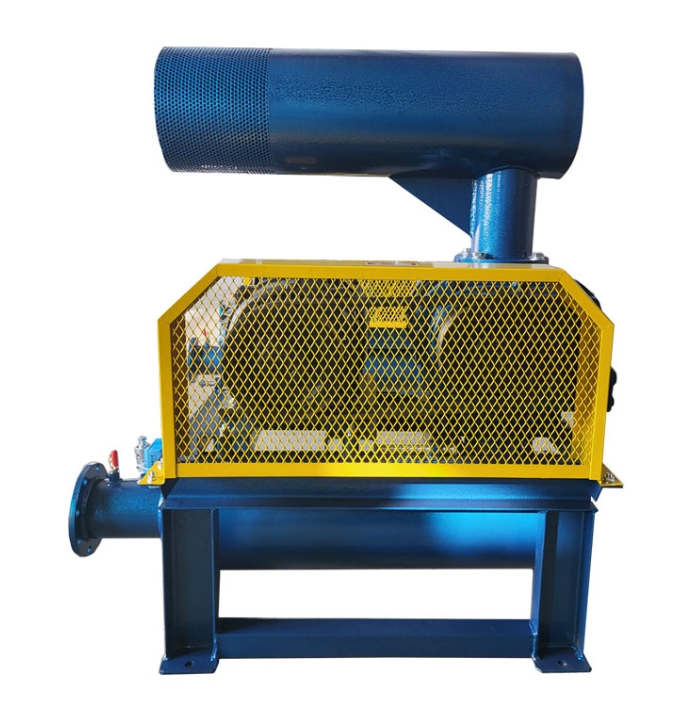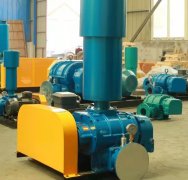The installation steps of a two blade Roots blower are similar to those of a three blade Roots blower, but special attention should be paid to its structural characteristics (such as rotor balance, large pulsation, etc.). The following is a detailed installation process and precautions:
---

**1、 Preparation before installation**
1. * * Check equipment and accessories**
-Check if the fan model, motor power, and inlet/outlet direction are consistent with the requirements.
-Check if the accessories (anchor bolts, shock pads, couplings/pulleys, flange gaskets, etc.) are complete.
-Confirm that there is no transportation damage to the two blade rotor (with a focus on checking if the blades are deformed).
2. * * Foundation construction**
-The foundation needs to be level and sturdy (concrete grade ≥ C20), and the size should be reserved with anchor bolt holes according to the manufacturer's drawings.
-Reserve surrounding space (≥ 1.5m) for easy maintenance.
---
**2、 Installation steps**
**1. Fan positioning and initial leveling**
-Lift the fan to the foundation using lifting equipment and insert the anchor bolts (not yet tightened).
-Use a spirit level to calibrate the levelness (vertical/horizontal error ≤ 0.2mm/m).
**2. Motor installation**
-* * Direct connection type * *:
1. Align the coupling (radial/axial deviation ≤ 0.05mm).
2. Use a dial gauge to adjust coaxiality and tighten the motor anchor bolts.
-Belt pulley type:
1. Ensure that the centerlines of the two pulley grooves are aligned (deviation ≤ 1mm).
2. Adjust the tension of the belt (by pressing with fingers, the sagging amount is about 10-15mm).
**3. Pipeline connection**
-The import and export pipelines need to be independently supported to prevent external forces from being transmitted to the fan.
-Add oil resistant rubber gaskets between the flanges, and gradually tighten the bolts diagonally to prevent leakage.
-Special attention should be paid to the two blade fan:
-It is recommended to install * * flexible joints * * for import and export to reduce pulsating vibration.
-If used in high-pressure scenarios, the outlet pipeline needs to be equipped with a silencer and a valve.
**4. Electrical wiring**
-Connect according to the voltage/current on the motor nameplate, with a grounding resistance of ≤ 4 Ω.
-When controlling the frequency converter, it is necessary to set * * low-frequency limit * * (to avoid increased pulsation of the two blade fan at low speeds).
**5. Lubrication and sealing inspection**
-Add designated lubricating oil to the gearbox (such as N220 gear oil to the centerline of the oil window).
-Check if the shaft seal (skeleton oil seal or mechanical seal) is intact.
---
**3、 Debugging and trial operation**
1. * * Manual turning gear**
-Remove the coupling/belt, manually rotate the rotor 2-3 times, and confirm that there is no jamming or abnormal noise.
2. * * Jogging test**
-Instantly start when powered on (≤ 1 second), check if the direction of rotation is consistent with the arrow on the housing (reverse rotation of the two blade fan will damage the blades).
3. * * No load operation**
-Run without load for 30 minutes, monitor:
-Is the current stable (≤ rated value).
-Bearing temperature (≤ 70 ℃).
-Vibration value (the vibration of the two blade fan is relatively large, but should be ≤ 4.5mm/s).
4. * * Load operation**
-Gradually close the outlet valve to the working pressure and observe the fluctuation of the pressure gauge (the pulsation of the two blade fan is obvious, and it needs to be confirmed whether the system can withstand it).
---
**4、 Precautions (Special requirements for two blade fan)**
1. Vibration control**
-The foundation needs to be equipped with * * shock absorbers * * (such as rubber shock pads) to avoid resonance.
-Regularly check the tightening of the foundation bolts (the two blade fan is prone to loosening).
2. * * Noise Management**
-It is recommended to install a soundproof cover or arrange it in an independent machine room (the noise of a two bladed fan is 5-10dB higher than that of a three bladed fan).
3. * * Maintenance cycle**
-The gear oil should be replaced every 500 hours for the first time, and every 3000 hours thereafter (usually 4000 hours for three leaf fans).
---
**5、 Common problem handling**
-Abnormal noise: Check the rotor clearance (standard clearance of two blade fan 0.15~0.25mm) and belt tightness.
-Overcurrent: Confirm if the pipeline is blocked and if the valve is fully open.
-Oil leakage: Replace the shaft seal (the load on the shaft seal of the two blade fan is greater, and a wear-resistant model should be selected).
---
**Summary**
The installation core of the two blade Roots fan lies in vibration reduction, centering, and sealing. Due to its high pulsation and noise, more attention should be paid to system compatibility. If it is an old equipment renovation, it is recommended to prioritize evaluating the feasibility of upgrading to a three blade fan. It is recommended to check the wear of the rotor every 3 months after installation.



